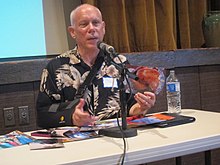Bill Atkinson
Bill Atkinson | |
|---|---|
 | |
| Born | March 17, 1951 |
| Nationality | American |
| Education | University of California, San Diego University of Washington |
| Occupation(s) | Engineer, inventor, nature photographer |
| Known for | Part of the Apple Lisa and Macintosh 128K development teams; conceived, designed, implemented HyperCard, the first popular hypermedia system; his 2004 book, Within the Stone |
| Website | billatkinson |
William "Bill" D. Atkinson[1] (born March 17, 1951) is an American computer engineer, computer programmer and photographer. Atkinson worked at Apple Computer from 1978 to 1990. Some of Atkinson's noteworthy contributions to the field of computing include Macintosh QuickDraw and Lisa LisaGraf (Atkinson independently discovered the midpoint circle algorithm for fast drawing of circles by using the sum of consecutive odd numbers),[2] Marching ants, the double-click, Menu bar, the selection lasso, MacPaint (FatBits), HyperCard, Atkinson dithering, and the app PhotoCard.
Education
[edit]He received his undergraduate degree from the University of California, San Diego, where Apple Macintosh developer Jef Raskin was one of his professors. Atkinson continued his studies as a graduate student in neurochemistry at the University of Washington.
Apple
[edit]Raskin invited Atkinson to visit him at Apple Computer; Steve Jobs persuaded him to join the company immediately as employee No. 51, and Atkinson never finished his PhD.[3][4] Atkinson was the principal designer and developer of the graphical user interface (GUI) of the Apple Lisa and, later, one of the first thirty members of the original Apple Macintosh development team,[5] and was the creator of the MacPaint application. He also designed and implemented QuickDraw, the fundamental toolbox that the Lisa and Macintosh used for graphics. QuickDraw's performance was essential for the success of the Macintosh GUI. He also was one of the main designers of the Lisa and Macintosh user interfaces. Atkinson also conceived, designed and implemented HyperCard, an early and influential hypermedia system. HyperCard put the power of computer programming and database design into the hands of nonprogrammers. In 1994, Atkinson received the EFF Pioneer Award for his contributions.
Career after Apple
[edit]Around 1990, General Magic's founding, with Bill Atkinson as one of the three cofounders, met the following press in Byte magazine:
The obstacles to General Magic's success may appear daunting, but General Magic is not your typical start-up company. Its partners include some of the biggest players in the worlds of computing, communications, and consumer electronics, and it's loaded with top-notch engineers who have been given a clean slate to reinvent traditional approaches to ubiquitous worldwide communications.[6]
In 2007, Atkinson began working as an outside developer with Numenta, a startup working on computer intelligence. On his work there Atkinson said, "what Numenta is doing is more fundamentally important to society than the personal computer and the rise of the Internet."[7]
Photography
[edit]Currently, Atkinson works as a nature photographer, focusing on close-up photographs of stones that have been cut and polished. His 2004 book Within the Stone features a collection of his close-up photographs. The detailed images he creates are made possible by the accuracy and creative control of the digital printing process that he helped create.
In popular culture
[edit]Actor Nelson Franklin portrayed him in the 2013 film Jobs.
References
[edit]- ^ US patent 4622545A, William D. Atkinson, "Method and apparatus for image compression and manipulation", issued 1986-11-11, assigned to Apple Computer, Inc.
- ^ Isaacson, Walter (2011). "Steve Jobs". Simon & Schuster. Retrieved December 22, 2011.
- ^ Walter Isaacson (October 7, 2014). The Innovators. Simon and Schuster. ISBN 978-1476708690.
- ^ Bill Atkinson interviewed on the TV show Triangulation on the TWiT.tv network
- ^ Lemmons, Phil (February 1984). "An Interview: The Macintosh Design Team". BYTE (Interview). Vol. 9, no. 2. p. 58. Retrieved October 22, 2013.
- ^ Halfhill, Tom R.; Reinhardt, Andy (February 1994). "Just Like Magic?". Byte. Archived from the original on July 13, 1997.
- ^ Schonfeld, Erick (March 6, 2007). "Jeff Hawkins and the Brain". Business 2.0. CNN. Archived from the original on June 25, 2007. Retrieved February 16, 2017.
